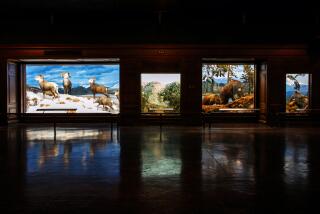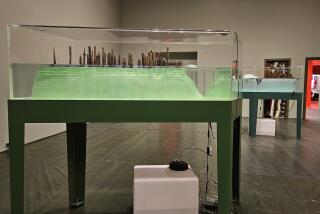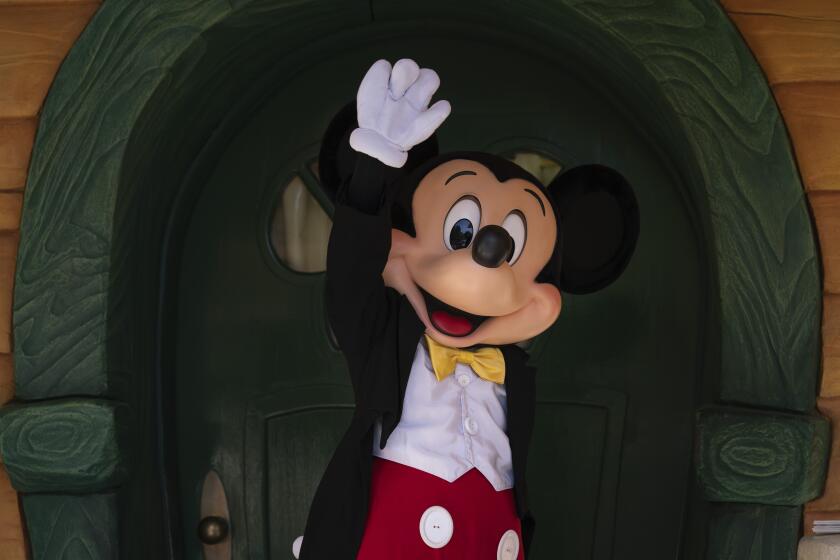Power, Politics and Planes
- Share via
In the final minutes of the hypnotizing 1997 film “Dial H-I-S-T-O-R-Y,” by Belgian artist Johan Grimonprez, the soundtrack fills with the seductive opening strains of Van McCoy’s 1975 smash, “The Hustle,” which ushered in disco. On the screen, an Air France jetliner glides into view from the distance, soaring over a pastoral green landscape toward an airport runaway.
Oooo-oo-oo-oo-oo! Do it!
The jet fills the screen as it passes the camera, while the background is transformed into a wavy blur of striated green, gold and blue. The mechanical bird slides by, just above the tarmac.
Oooo-oo-oo-oo-oo! Do it!
The ship sails silently beyond the end of the runway, as if straining for the release promised by the lush string orchestration of the gently driving music, then clips the tree tops of a densely wooded field before disappearing from view behind a sea of verdant green leaves. After one breathless moment, the forest erupts into a gargantuan ball of fire and black smoke. The music peaks--Do the hustle!--and the credits roll. Five more planes crash in slow motion, on land and in the sea, to the joyful disco beat.
“Dial H-I-S-T-O-R-Y,” currently being shown in the Project Room at the Santa Monica Museum of Art, is a cinematic meditation on international terrorism, in general, skyjacking, in particular, and on the entertainment value of mammoth violence in a world driven by mass media. In stark and trenchant contrast to today’s simplistic prattle about the struggle between good and evil, it refuses to see the world in black and white terms. The final moments of hustle are emblematic.
Beautiful, horrifying, silly, seductive, painful to watch and impossible to turn away from, the complex montage of found film, video footage and sound assembled by Grimonprez creates a kaleidoscopic tapestry. The global phenomenon of terrorist skyjacking, which arose late in the 1960s and accelerated in the 1970s, is yoked to the simultaneous proliferation of mass-media entertainment. If Washington is Hollywood for ugly people, skyjacking is show business for the ugliest of politics.
Grimonprez’s 68-minute film was among the spare handful of bright moments in the otherwise artistically arid 1997 edition of Documenta, the sprawling international survey of contemporary art held every five years in Kassel, Germany. (The next installment opens June 8.) There, it was transferred to video and projected alone on the white wall of a small gallery, like electronic wallpaper or an epic TV mural. Crowds packed the room, mostly staring in stunned silence.
At the Santa Monica Museum, Grimonprez has reconfigured the presentation. The Project Room has been turned into a cross between a public lounge and a suburban den. Bean-bag chairs are clustered around big Sony television sets. Low, oval tables are painted bright orange, while cobalt blue curtains cover one wall. A coffee maker percolates nearby.
It’s a period room--the period roughly coinciding with the 1960s ubiquity of both terrorist skyjacking and mass media. And because a lot of current design nostalgically recalls that sleek, pop, futuristic style, the period the room evokes oscillates between present and past.
The events of Sept. 11 are never declared outright, but they’re inescapably evoked. We watch the politically driven spectacle of monumental airplane disasters on TV, as we did the destruction of the World Trade Center. Grimonprez, a Belgian artist based in New York, calls the room an in-flight video lounge--and indeed, the disorienting feeling is of being permanently suspended between points of departure and arrival.
A shelf at one side features a diverse array of more than 40 videos that can be popped into the VCR. In addition to “Dial H-I-S-T-O-R-Y,” they range from glossy Hollywood fare like “Air Force One,” “Airport” and “The Wizard of Oz” to straight documentaries on travel, tourism and politics. The 1957 “I Love Lucy” episode in which Superman (George Reeves) saves the redhead from the ledge of a building is there, along with the 1975 cinematic adaptation of “Society of the Spectacle,” the influential book by the brilliant, autocratic theoretician Guy Debord, who was instrumental as a catalyst for the 1968 student revolts in France.
Also available for perusal is a copy of “Inflight,” the artist’s slick magazine of arresting hijack stories. Promoted on the cover beneath a grainy video image of airplanes being blown up at a desert airstrip in Jordan. “What to do with a stolen Boeing 777.”
Grimonprez builds on a Pop art aesthetic. (Think of Andy Warhol’s 1962 painting of a tabloid newspaper, whose blaring headline screams “129 Die in Jet!”). He’s a master at montage. “Dial H-I-S-T-O-R-Y” opens with the first transatlantic hijacking, executed in 1969 by an American Vietnam vet who commandeered a plane in Los Angeles and took it to Rome. Soon Grimonprez brings in clips of early 20th century film efforts to represent flying, as well as documentary footage of early attempts to fly. The romance of flight gets enmeshed with the growth of mediums of mass reproduction. Power and politics are entangled in the mix.
Both the failed flying machines from the turn of the century and the grainy black-and-white film soon seem comical and old-fashioned--not nearly so inspiring as the sleek video imagery and spectacular explosions of today. Grimonprez induces such queasy responses in a hapless viewer, who becomes the self-conscious gawker at history’s monstrous roadside pile-up.
When he slips in a 1965 hijacking from Hungary to the West--a daring freedom ride from behind the Iron Curtain--motive takes a murky spin. Was that a good act of hijacking?
And the Dallas psychologist who knowingly explains to a television reporter that the airline whose flight attendants wear the shortest skirts have been the target of a lopsided number of attacks gives a freaky Freudian analysis of the motives of men with guns. Grimonprez smartly follows with footage of Leila Khalid, the Palestinian woman who, with different boyfriends, pulled off a TWA hijack in 1969 and an El Al hijack in 1970. Freud wondered what women want, but to my knowledge wrote nothing about terrorist politics as prime-time entertainment.
Khalid was among a group of commandos who, on a Sunday afternoon in 1970, snared four airplanes shortly after take-off from three different European airports (Frankfurt, Zurich and Amsterdam) and headed for the Middle East. Imagine! Four airplanes hijacked by terrorists simultaneously. It would be unbelievable if we hadn’t seen it on TV.
*
“Johan Grimonprez,” Santa Monica Museum of Art, Bergamot Station, 2525 Michigan Ave., Santa Monica, (310) 586-6488, through June 9. Closed Monday.
More to Read
The biggest entertainment stories
Get our big stories about Hollywood, film, television, music, arts, culture and more right in your inbox as soon as they publish.
You may occasionally receive promotional content from the Los Angeles Times.











